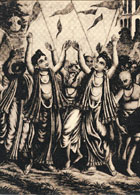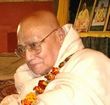

sri-sanatana-misro'yad pura satrajito napa |
vinupriya jagan-mata yat-kanya bhu-svarupii ||
He who was King Satrajit in Krishna lila was Sanatan Mishra in Chaitanya lila.
The mother of the universe, the incarnation of the Lord's bhu-sakti,
is his daughter Vishnupriya. (Gaura-gaoddesa-dipika 47)
In the Adikhaa, the death of Mahaprabhu's first wife is described, and then his second marriage to the daughter of the court pandit. (Chaitanya Bhagavat 1.1.110)
Then he was married to Vishnupriya Thakurani, after which he defeated the Digvijayi Pandit. (Chaitanya Charitamrita 1.16.25)
For the materialistic person, the marriage of a man and woman is the source of bondage. When the Lord marries in imitation of ordinary mortals, it becomes a something quite different: it is a transcendental affair. By chanting and hearing about the union of the Supreme Lord with his divine energy, one is liberated from the material energy.
Whoever hears about the holy pastime of the Lord's marriage will be liberated from his bondage to this world. Lakshmi sat beside the Lord and the house of Sachi was filled with light. (Chaitanya Bhagavat 1.10.110-1)
Whoever saw the Lord's effulgent form on that day was freed from his or her sins and went to Vaikuntha. This is why the Lord is known as the merciful lord of the fallen. (Chaitanya Bhagavat 1.15.216-7)
Mahaprabhu spent an inordinate time absorbed in teaching his students on a trip to eastern Bengal, and Lakshmipriya Devi found it impossible to support his absence. So, meditating on his lotus feet, she departed from this world. When Mahaprabhu finally arrived back in Nabadwip, he consoled his mother who was deeply affected by the loss of her daughter-in-law. Sachi Mata then started looking for another wife for her son and consulted Kashinatha Pandit for that purpose. Kashinatha was a well-known matchmaker who is described in Gaura-gaoddesa-dipika (50) as having been the Brahmin in Krishna lila named Kulaka who was sent by Satrajit to arrange the marriage between his daughter Satyabhama and Krishna. He then went to the court pandit Sanatan Mishra to arrange the marriage between Mahaprabhu and his daughter, the devotionally minded Vishnupriya. Kashinatha said the following to Sanatan Mishra:
Give your daughter to Vishvambhara Pandit; it is a perfect combination. She alone is worthy of such a divine husband, while he deserves such a pious and chaste wife. Just as Krishna and Rukmii were worthy of each other, so are Vishnupriya and Nimai Pandit. (Chaitanya Bhagavat 1.15.57-59)From her early childhood, Vishnupriya Devi was always devoted to her parents and to Vishnu, taking her bath in the Ganges three times daily. She regularly saw mother Sachi there, paying obeisances and being blessed by her. In this way, Sachi already knew Vishnupriya's good qualities, and so was happy to agree to accept her as a wife for her son. Buddhimanta Khan was a rich and wise friend of Nimai's family who volunteered to bear the entire expense of his marriage. Once it had been decided that Vishnupriya and Vishvambhara would be married, an auspicious day and moment were fixed for the ceremony. With great pomp, the adhivasa rituals were carried out on the eve of the marriage. The Lord arrived at Sanatan Mishra's house in a palanquin at dusk and Gaura and Vishnupriya's wedding ceremony was performed according to both scriptural and popular traditions. On the following day, Vishnupriya joined her new husband on the palanquin and returned with him to his house. If one hears the eternal pastime of the wedding of Lakshmi and Narayan, then he loses his desire for the material relationship of enjoyer and enjoyed, for one comes to understand that Narayan alone is the supreme enjoyer of the entire universe. Buddhimanta Khan was fulfilled by receiving Mahaprabhu's embrace and mercy. Vrindavan Das Thakur has further written the following about the wedding:
Some people of the pious women said, They remind me of Gauri and Shiva. Others said, It seems that they are Lakshmi and Narayan. Yet others said, No, they rather resemble Rati and Kamadeva. Some compared them to Indra and Sachi, and others to Rama and Sita. (Chaitanya Bhagavat 1.15.205-8)
The earth splits from the sound of Vishnupriya's crying: the birds and beasts, even the trees and stones shed tears when they heard it. Falling to the ground she would lament, crying out Why does my sinful life not end? In separation, her breath was like fire, drying her lips and her body trembled constantly. (Cm 2.14.15-6)The Advaita-prakasa also describes how Vishnupriya lived her life in terrible separation from the Lord after his departure. Every morning, she would go for her bath in the Ganges with mother Sachi, after which she spent the entire day inside the house, never allowing the moon or the sun to see her form. Not even the devotees were allowed to see anything more than her feet, nor would anyone ever hear her voice. Constantly shedding tears and eating only Mother Sachi's remnants, she became pale and thin. She took intense delight in the Holy Name, chanting all day long in solitude before a portrait of Gauranga, serving it as though he were present in it and surrendering herself to his lotus feet. In this way, she demonstrated the ideal character of a devoted wife as well as the forbearance spoken of by the Lord in his verse, taad api sunicena taror iva sahinuna, etc. Srinivas Acharya received Vishnupriya Devi's blessing. He personally witnessed her devotion to Mahaprabhu in separation. Narahari Chakravarti has described this in his Bhakti-ratnakara:
Every day Srinivas would come to see her. He observed her daily activities, which are beyond description. She had completely renounced sleep, and if ever she closed her eyes, it would be while lying on the bare ground. Her bodily luster, which had formerly glowed more brilliantly than gold, had become dull and she was as thin as the waning moon on its fourteenth day. She set aside grains of rice to count the Holy Names she chanted, and would cook only this rice and offer it to her Lord. Of this amount, she would only eat a small portion. No one understood how she could remain alive. (BhaktiR09;ratnakara 4.47-51)Jahnava Devi's disciple Nityananda Das has also described the standard Vishnupriya Devi set for bhajan in his Prema-vilasa.
Listen, brothers, to the way which Isvari Vishnupriya would take the names of the Lord. By listening to this, you will get a feeling for the lila. Every day she would place two clay pots on either side of her, one filled with uncooked rice, the other empty. Each time she completed one mantra of sixteen names and thirty-two syllables, she would joyfully place a grain of rice into the empty container. She would chant in this way until three o'clock in the afternoon, and then would take whatever rice had accumulated and cook it. This is the only food that she prepared, drenching it with her tears before she offered it to the Lord. It is not possible to estimate how many names Mahaprabhu himself chanted, but he chanted all day and night. Similarly, his beloved wife Vishnupriya chanted incessantly through the day and the night. Such dedication to the Holy Name was not impossible for her, for the Lord had planted the seed of his power in her.
It is said that Vishnupriya Devi was the first to establish worship of a murti of Gauranga. This has been stated in Murari Gupta's kaaaca:
prakasa-rupea nija-priyayaKrishna came to his beloved wife in this expansion form to remain by her side as the Mahaprabhu deity. Thus she, the incarnation of the goddess of fortune, was able to serve him constantly.
samipam asadya nijad hi murtim |
vidhaya tasyad sthita ena kana
sa laknmi-rupa ca ninevate prabhum ||
The devotees of Mahaprabhu sometimes said that just as Ramachandra, who had taken the vow of monogamy, performed a sacrifice to a golden Sita that he had had made during his exile in the forest rather than marry a second time, so Vishnupriya repaid her debt to her Lord in the pastimes of Gaura-Narayan by having an image of Mahaprabhu created so she could perform the sacrifice of the Holy Name to him. This deity is still present and worshiped in Nabadwip.
Sri Vamsivadana Thakur and Ishan Thakur were blessed by the service of taking care of Vishnupriya Devi and Sachi Devi after Mahaprabhu took sannyas.
For more articles on a variety of devotional topics by and about Srila Bhakti Ballabh Tirtha Maharaj and other Vaishnava authors, kindly visit the GOKUL website at http://www.gokul.org.uk or http://www.sreecgmath.org For more information, or to subscribe to our newsletter, write to bhakti@gokul.org
![[BVML Home Page]](../grfx/bml_logo.gif)
